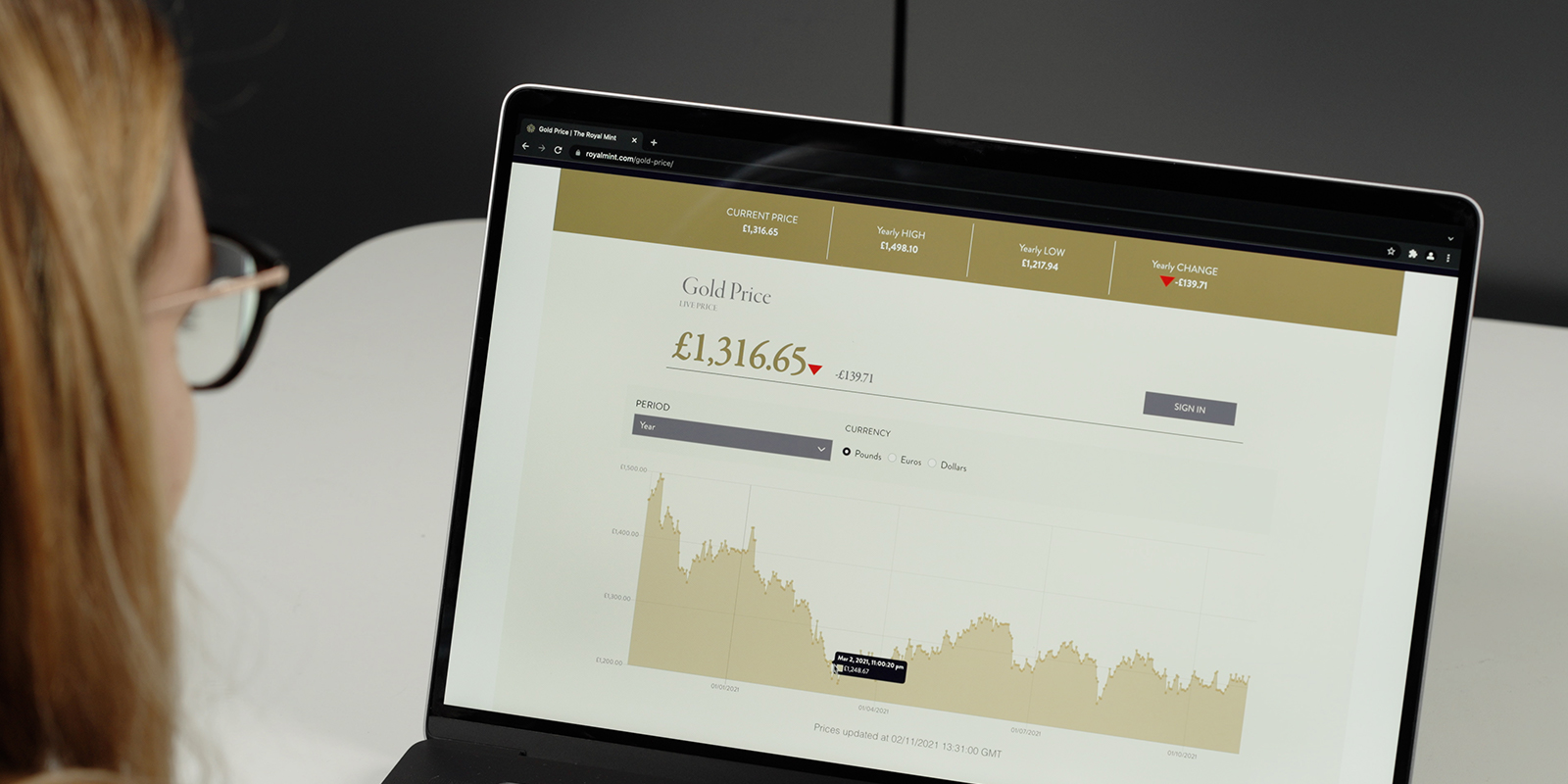With 2021 officially drawn to a close, we take a look back at some of the key stories that affected the precious metal markets throughout the year, and what it could mean for 2022.
January 2021
January opened with a positive outlook with suggestions that markets would gradually begin to return to some semblance of normality in the coming months following the global rollout of the Covid-19 vaccine. The suggestion was coupled with a proviso that restrictions were likely to remain in place until the second-half of the year. In the USA, following a turbulent four-years of presidency under Donald Trump, the new US President, Joe Biden, was inaugurated on the 20th of January with many predicting that markets would continue to stabilise as a result.
The precious metals markets also began to react positively with market prices on the rise. Analysts at CitiBank, HSBC and Metals Focus all predicted that the gold price would likely rise above the key threshold of $2,000 per ounce in 2021, with Metals Focus even predicting a rise above $2,300.
This rosy outlook was largely due to higher than expected unemployment rates in key economies, coupled with an expectation of increased fiscal spending to support economic recovery, especially in the USA. Such measures are traditionally regarded as drivers of gold demand, so the market was generally poised for a shake-up.
February 2021
The news throughout much of February was focussed around shares in US consumer retailer ‘GameStop’ as users of the internet forum Reddit persevered in their attempts to orchestrate a short squeeze of the share price and boost the value. These measures were successful in raising the value of the stock from under $5 to over $400.
Following this successful stock market ‘squeeze’, users then moved onto precious metals, in an attempt to increase the price of silver. This surge in demand led to many retailers being overwhelmed with demand for silver coins and bars. The Royal Mint reported that towards the start of the month, sales of silver were over seven times the average daily amount as thousands of new customers flocked to the website. The London Bullion Market Association (LBMA) recorded over one billion ounces of silver sold at the start of the month with the price rising to its highest levels since 2003.
Efforts to boost the price were short-lived however, as although highs of nearly $30 an ounce were achieved, towards the end of the month, the price had fallen back to around $26 per ounce.
Towards the middle of the month, signs of an initial recovery of the US labour market had an impact on the gold price, and it fell below the $1,800 barrier. However, President Biden announced news of a possible Covid-19 relief package in February, which provided an initial boost to market prices.
Platinum also performed well in February as towards the end of the month, the price rose above $1,300 – a level not reached for more than six years. This was driven by an expected increase in industrial demand leading to a tighter international supply of the metal.
March 2021
The gold price hovered around $1,700 throughout most of the month resulting from a positive economic outlook, especially in the USA. Following speculation of a Covid-19 relief package in February, March saw the House of Representatives pass the $1.9 trillion coronavirus relief bill which drove further recovery throughout the month. This stimulus package meant that most American citizens would receive a direct payment of $1,400 and would extend a $300 per week unemployment insurance boost.
Towards the middle of the month, a meeting of the Federal Reserve concluded by ramping up the expectations for economic growth and recovery, but also indicated that no interest rates hikes were likely in the coming year. The policymaking Federal Open Market Committee also voted to keep short-term borrowing rates at their position of near zero.
In relation to the months ahead, many analysts predicted continued support for gold, particularly in the second half of the year. James Steel, Precious Metals Analyst for HSBC cited low interest rates and a potential ease in inflationary pressure, and consequently a fall in yields, to be potential drivers of a recovering gold price in the latter half of 2021.
April 2021
Throughout April 2021, the gold price ranged from a low of $1,715.85 at the start of the month to a high of $1,798.20 by the third week - a range of nearly 4.8% and heading perilously close to the key $1,800 threshold. The silver price was also active throughout the month, ranging from a low of $24.31 at the start of the month, to a high of $26.30 – again by the third week.
News of ongoing economic improvements continued in key markets including the USA, India and China. In India, despite the ongoing Covid-19 pandemic, imports of gold had surged to 160 tons during March. This was an increase of over 470% compared to the same period in 2020.
China - another key international consumer - indiciated a similar positive outlook for gold, as the Shanghai Gold Exchange (SGE) reported that gold withdrawals for March 2021 were more than double those reported in the same month in 2020.
Towards the end of April, the World Gold Council released their quarterly gold demand trends report for Q1 of 2021. This reported that demand for gold in the consumer sector appeared to have increased in the first part of the year; jewellery purchases were reported to have risen by over 50% year on year. This strong improvement in demand for jewellery was a direct contrast to the decline in sales during the global lockdowns in Q1 2020, and was suggested to be an indication that consumer sentiment was increasing as economies emerged from lockdown and headed towards recovery.
May 2021
May 2021 was a volatile month for the gold price with a low of $1,778.05 at the start of the month to a high of $1,904.30 towards the middle of the fourth week – a difference of over 7% and breaching the $1,900 barrier for the second time in 2021.
Economic demand and recovery continued throughout the month with news from China that Q1 gold demand consumption had risen by nearly 94% year on year due to talk of further economic recovery in the area. In contrast to this, the ongoing impact of the Covid-19 pandemic in India continued to affect the country’s physical gold market with dealers selling gold at discounts of up to $2 per ounce in an attempt to increase demand.
In Russia, the Central Bank stated in their annual report that in 2020, it had reduced its holdings of EUR, USD and GBP in favour of gold, the Chinese Yuan and other currencies. Whilst their holdings of dollars decreased by 3.3% to 21.2% overall, their gold reserves increased to 23.3% from 19.5% a year earlier. As well as importing gold, Russia continued to be one of the world’s largest producers of the precious metal, second only to China. In a report by consultancy and analytics firm Institute of Geotechnologies, it was suggested that if Russia maintained its current growth trajectory; it would become the world leader in gold mining before the end of the decade.
June 2021
June opened with an investment update report from The World Gold Council suggesting that gold had proved to be one of the most stable asset classes from a volatility perspective, both during the market disruption seen during the pandemic and the subsequent rebound. This is because the price of gold during the first part of 2021 had remained relatively stable, especially when compared to other investment options such as cryptocurrencies, which continued to be a volatile choice.
Other cryptocurrency news included a crackdown on the cryptocurrency industry in China, resulting in a decline of around $400 billion off the value of the cryptocurrency market over the course of just 3 days. This decline followed an announcement that authorities in China ordered cryptocurrency miners to shut down their operations. The People’s Bank of China also applied pressure on financial institutions not to provide services related to cryptocurrency activities, including clearing and settlement.
Speculation of upcoming inflation was also apparent throughout the month with central banks across the world increasing their gold purchasing and subsequent gold reserves. During the first four months of 2021, the sector purchased between 150-200 tonnes of gold, a significant portion of which came from banks from central and eastern Europe. This was because Hungary reported that they had tripled their gold reserves to a total of 95 tonnes while Poland added over 200 tonnes to their national reserves. Thailand also boosted numbers by adding between 40-50 tonnes between April and May 2021 alone. In conjunction with the rise, the Hungarian central bank issued a press release which referenced “new risks arising from the coronavirus pandemic” as playing a key role in its decision to add to its reserves.
Concerns of inflation continued throughout the month following a policy statement from the U.S. Federal Reserve. Following the two-day policy meeting, the gold price fell below $1,800 amid tightening optimism about the labour market alongside heightened concerns around inflation. In what was described by many as a ‘hawkish’ move, Fed Chair Jerome Powell said the central bank would begin a discussion about scaling back bond purchases and now predicted that the first rate hike would take place in 2023. This announcement sent the dollar to an over two-month high.
July 2021
The gold price held around the $1,800 per ounce mark for much of July as a weaker US Dollar and lower US Treasury yields bolstered the appeal. The price only fell below the $1,800 barrier for a brief period before quickly recovering and staying relatively stable throughout the month. Some market analysts suggested that this would form a new base for the price to increase, citing the continuing ongoing political and economic uncertainty some of the main drivers.
As restrictions continued to ease throughout the world, many countries reported strong initial demand in many sectors. Some gold dealers in India reported that towards the start of July, gold was being sold at a premium of up to $3 an ounce, compared to discounts of over $20 seen in recent months.
The news throughout July focussed around ongoing concern of inflation and the impact on the wider-markets. By mid-July, inflation in the USA was said to have reached a 13 year high. In the UK, the consumer price index recorded a measure of 2.5% in June, which, although less than half that of the USA, was higher than the 2% target set by the Bank of England.
The World Gold Council updated the central bank buying figures in July, which continued to suggest that central banks across the world had begun to increase their gold reserves further, with notable purchases from Russia, Thailand and Turkey. Brazil was also a somewhat unexpected addition to the list of purchasers as it was reported that the Brazilian Central Bank added 41.8 tonnes of gold to their reserves in June, increasing the overall holdings by 52.7%.
By the end of June 2021, vaults in London were reporting record amounts of vaulted silver, with totals standing at 36,706 tonnes; valued at $30.4 billion. Alongside this impressive valuation, there was also recorded to be 9,587 tonnes of gold, valued at $543.5 billion, all of which are held in a combination of commercial vaults, coupled with the Bank of England’s gold holdings.
In news from The Royal Mint, July saw the release of the annual report, which confirmed a £12.7 million operating profit. The report noted that strong performance throughout the year had been driven in part by strong demand for precious metals and as a result, had attracted over 25,000 new investors to its platform. In addition, digital savings accounts, like DigiGold, had contributed to a 430% increase in millennials investing in gold through The Royal Mint.
August 2021
The gold price experienced a ‘flash crash’ at the beginning of August, falling by 5% in the week leading to Wednesday 11th. The temporary price dip provided individual investors with an opportunity to buy at a lower price, resulting in a 96% increase in demand for bullion coins, bars and DigiGold from The Royal Mint. It did not take long for the gold price to recover however, rising by over 4% in the week that followed amidst growing concerns around Covid-19 variants and in anticipation of the impending Federal Reserve meeting. During his Jackson Hole speech on 27th August, Fed Chair, Jerome Powell, gave a dovish outlook for monetary policy leaving many analysts questioning whether a sudden rise in Covid-19 cases in the US might encourage the Federal Reserve to defer plans for tapering monetary stimulus. Before the end of the month, the gold price breached the $1,800 barrier again.
Towards the end of the month, The World Gold Council also released their Q2 Gold Trends report, which outlined a positive trend for gold coin and bar demand globally. The report described a fourth consecutive quarter of year-on-year gains for physical bullion, with 243.8 tonnes purchased over the three-month period. In addition, it revealed that central banks continued to buy gold throughout the quarter and that demand for gold jewellery was up by 60% year-on-year - although still below its five-year average.
September 2021
September opened with the gold price hovering around the $1,815 mark ahead of the much-anticipated US non-farm payrolls data that many suggested was crucial for the Federal Reserve’s tapering timeline. Following the release of the data, the US dollar index fell to its lowest level in a month and both gold and silver saw price increases, edging gold to a near 7-month high. This was because the 235,000 non-farm payroll increase fell well short of the 750,000 which was predicted by the wider market.
Seasonal patterns since 1971 suggested that September should have been the best performing month of the year for gold, with an average growth of just over 2% historically - but in 2021, this was not to be. Opening the month at $1,818, gold closed the month down 2.50%. Factors including a rising US 10-year Treasury bond yield, a firm US dollar, plus ongoing strength in equity markets provided strong headwinds for gold as the Fed issued a number of hawkish statements on the outlook for employment and by extension, plans for tapering.
In cryptocurrency news, following on from crackdowns of cryptocurrency trading in the region earlier in the year, in September, The Peoples Bank of China said all services relating to trading, order matching token issuance or derivatives for virtual currencies are prohibited - effectively banning cryptocurrencies in the country. Overseas crypto exchanges providing services to mainland China were also made illegal, the PBOC said. Following the announcement, the price of Bitcoin fell by more than $2,000.
Lastly, in a report by The Royal Mint, it was found that although many young investors turned to cryptocurrencies or so-called ‘meme stocks’, such as GameStop, in recent months, almost two thirds polled said they had already sold some or all of their holdings in favour of safer options, including gold. More than half of the respondents also suggested that their crypto or meme investments had been less successful than hoped and almost 70% considered precious metals as a result.
October 2021
During October 2021, gold covered a range of over 3%, from a low of $1,748.25 an ounce in the first week to a high of $1,801.90 in the last week of the month, breaking that crucial $1,800 barrier once again. Silver covered an impressive range of 10.32% over the month, with a low of $22.09 at the start of October, to a high of $24.37 in the last week. Frequently, when we see little movement in the gold market, the price of silver will drift lower and the gold: silver ratio widens. However, the ratio sat at less than 75 during this period and appeared to be on a generally positive trend when measured across recent months. The increases in both gold and silver towards the end of the month were mainly driven by ongoing concerns around inflation ahead of the upcoming meetings of the US Federal Reserve as well as similar meetings of the Bank of Japan and the European Central Bank.
In Russia, a report from the chief executive of Polyus, Russia’s largest gold producer, suggested that at the current rate of production, gold resources in the country could be completely depleted within the next two decades. The pace of mining and gold production has increased dramatically in recent years in an attempt to speed up recovery following the pandemic. However, with reports suggest underground gold deposits in the country amounting to around 8,000 tonnes, but the current rate of extraction is around 330 tonnes a year.
A survey by YouGov of India reported that urban Indians intended to spend more on Diwali in 2021 than they did in previous years. Weddings and festivals are important drivers of demand in India and as shopping opportunities were severely limited due to the pandemic in 2020; many consumers were looking to treat themselves and others during 2021. Of those surveyed, 28% suggested they would like to purchase gold, with millennials more likely than other age groups to turn to the yellow metal. This was reflected in customer behaviour at The Royal Mint, as a newly developed gold minted bar, featuring Lakshmi- the Hindu goddess of wealth and prosperity was launched in time for Diwali and sold out within days, receiving extremely positive feedback from the Indian community in the UK as well as internationally.
During October, The Royal Mint also revealed plans were underway to build a plant in Wales which would be capable of extracting hundreds of kilograms of gold and other precious metals from e-waste. To achieve this, The Royal Mint had partnered with Canadian start-up Excir which is said to have developed chemical solutions to extract these precious metals from circuit boards. Sean Millard, Chief Growth Officer from The Royal Mint suggested that the technique is able to extract precious metals with a high degree of purity and would look to process hundreds of tonnes of waste per year when the plant is in full operation.
November 2021
November proved a busy time for those following the gold price, as we saw movements of over 6% in USD and over 7% in GBP terms. November saw the price hover above the $1,800 mark for much of the month, only dropping again in the final week. The silver price was also similarly buoyant with a range of 8.78% in USD, with an average price of $24.26 during the month.
In USA news, Jerome Powell, chair of the US Federal Reserve, signalled that the Fed was set to start tapering the $120 billion monthly bond purchasing programme in the coming months – a suggestion to many that the short term low interest rate implemented at the start of the pandemic was set to end.
Raising the rate would affect everyone, from individuals to businesses, but is was said to be a necessary step to ensure that inflation did not spiral out of control. However, with inflation at the highest point in three decades, some market commentators suggested that this was a risky balancing act which could discourage spending before the market has regained full health.
Industry data released by the China Gold Association suggested that gold consumption in the country was up nearly 50% in the first three quarters of 2021. This rebound was said to be due to “a stable and ongoing recovery of the domestic economy”. The total gold consumption in the area was reported to be in the region of 813.59 tonnes in the January to September period, an increase of 48.44% year on year, while consumption of gold jewellery soared by over 54.21% over the same period.
Although in previous months, much of the news had focussed on the ongoing economic recovery, towards the end of the November, following the announcement of the ‘Omicron’ variant of Covid-19, global markets fell and the spot gold price rose as investors sought the safe haven of gold. In addition, following the announcement by Stephane Bancel, the CEO of Moderna, that existing vaccines may prove less effective against the variant, the Dow Jones and the S&P 500 share indexes fell by 1.8% while the tech-focused Nasdaq was down 1.9%. These declines also followed comments by the Chair of the Federal Reserve which suggested that the emergence of the new variant would worsen uncertainty around the economic recovery and inflation.
December 2021
December brought the inflation news that many had been predicting. Although the Bank of England aims for a 2% rise in inflation each year, by December 2021, the rate of inflation in the UK had risen to 5.1% - the highest rate in a decade. The speed of increase had taken market commentators by surprise as in November the Bank of England said it expected inflation to peak at 5%, but not until April next year.
This sudden rate-hike was driven by higher prices for a number of items including transport, food, clothing and footwear. Although in percentage terms, transport costs were the greatest contributor to the rise, other factors such as second hand car prices had also influenced the increased figures seen.
The rate of inflation also exceeded expectations in the USA, where The Consumer Price Index — a commonly used measure of US inflation — rose 6.8% year-on-year. This exceeded the 6.7% forecast and demonstrated the highest price growth since 1982- when Ronald Reagan was president.
International demand for gold continued to be favourable. In China, as reported by Shanghai Gold Exchange, withdrawals for the whole of 2021 exceed the totals for 2019 and 2020 put together. This figure was said to indicate a partial recovery in China from the ongoing Covid-19 impact. Imports and demand for gold in India was also ahead of previous years, exceeding expectations from some analysts.
Recap and Recollection on 2021
Following the tremendous amount of market turmoil and uncertainty seen in 2020, 2021 would prove a quiet and uneventful year in comparison. However, in isolation, 2021 was not without surprises of its own.
The gold price saw a lot of movement throughout the year, starting from a high of $1,957.20 in January, to a low of $1,683.95 by March – a fall of nearly 14%. The price did recover steadily throughout the year however, closing the year on $1,820.10 by the last day of trading. This also meant that the predictions of nearer $2,300 per ounce suggested by some market commentators were not met.
Although towards the end of the year, much of the news focused on record levels of inflation, the more recent news that the ‘Omicron’ Covid-19 variant may be less severe than previously thought could prove favourable to market conditions and the influence on the wider economy.
We enter 2022 with a degree of uncertainty, but with high levels of hope and optimism at what the future months and years may bring.
Wishing you a happy, healthy and prosperous 2022 from all the team at The Royal Mint. To find out more about our views on the future of precious metals, read our 2022 Outlook for Precious Metals.




